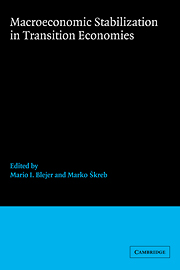Book contents
- Frontmatter
- Contents
- List of Contributors
- Preface
- Introduction Stabilization After Five Years of Reform: Issues and Experiences
- PART I GENERAL STUDIES
- PART II COUNTRY STUDIES
- 5 Inflation and Stabilization in Poland, 1990–95
- 6 The Political Economy of the Hungarian Stabilization and Austerity Program
- 7 Preparation and Implementation of a Credible Stabilization Program in the Republic of Croatia
- 8 Exchange Rate and Prices in a Stabilization Program: The Case of Croatia
- 9 Stabilization in Slovenia: From High Inflation to Excessive Inflow of Foreign Capital
- 10 Macroeconomic Stabilization in the Baltic States
- 11 Economic Reform in Ukraine
- PART III AFTERWORD
- Index
7 - Preparation and Implementation of a Credible Stabilization Program in the Republic of Croatia
Published online by Cambridge University Press: 09 October 2009
- Frontmatter
- Contents
- List of Contributors
- Preface
- Introduction Stabilization After Five Years of Reform: Issues and Experiences
- PART I GENERAL STUDIES
- PART II COUNTRY STUDIES
- 5 Inflation and Stabilization in Poland, 1990–95
- 6 The Political Economy of the Hungarian Stabilization and Austerity Program
- 7 Preparation and Implementation of a Credible Stabilization Program in the Republic of Croatia
- 8 Exchange Rate and Prices in a Stabilization Program: The Case of Croatia
- 9 Stabilization in Slovenia: From High Inflation to Excessive Inflow of Foreign Capital
- 10 Macroeconomic Stabilization in the Baltic States
- 11 Economic Reform in Ukraine
- PART III AFTERWORD
- Index
Summary
POLITICAL FRAMEWORK
Croatia fought for and achieved its political independence in the early nineties, at a time of major changes in Eastern Europe. The process evolving in Croatia has since its beginning been democratically oriented and was triggered by democratic elections. Two principles formed the basis of our national credo: market economy and high democratic social standards.
However, the Yugoslav leadership of that period, under dominating Serbian influence, decided to wage a war against Croatia – exploiting all resources of the former state, especially the military. Croatia found itself in the position of facing radical sociopolitical structural changes while at the same time being exposed to the brutal aggression triggered by Serbian ambitions.
With the exception of a few individuals and states, the world did not understand our situation, so that Croatia faced dramatic moments for its existence. We were exposed to international pressure after being unjustly labeled as a state that does not respect human rights and freedom of the press. At that time, however, Croatia experienced the massive political support of its population in forming the state and implementing a program for independence and international affirmation of state interest.
In spite of adverse circumstances, Croatia continues to abide by the ideals of a democratic society, a state of law, and a market economy. Even in the most critical moments of the war, Croatia persevered in the implementation of its privatization and reconstruction program.
- Type
- Chapter
- Information
- Macroeconomic Stabilization in Transition Economies , pp. 204 - 211Publisher: Cambridge University PressPrint publication year: 1997

